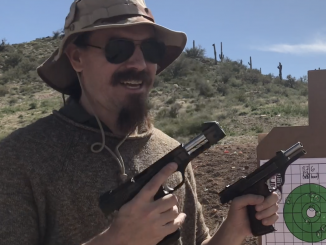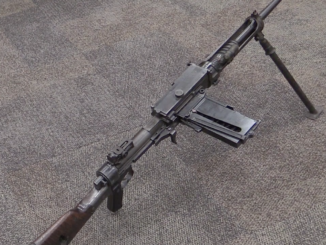When Italy signed an armistice with the Allied powers in 1944, the German military took over control of several Italian arms factories still in their geographic control. These included Beretta and Armaguerra, in Cremona. The German military was happy to use Italian pistols and submachine guns, and under their control the Armaguerra plant set up a production line for the Beretta M35 pistol, in .32ACP (7.65mm Browning). Only about 400 were made before the end of the war, and they show very crude machining, typical of “last ditch” arms worldwide. Curiously, the safety markings were reversed on these guns, compared to the standard Beretta production…
Related Articles

Semiauto pistol
Benelli B76 vs MP3S at the Range
The Benelli MP3S is a very rare pistol in .32 S&W, and a nearly unheard of one in 9mm Parabellum. Well, thanks to viewer Todd we have one of those 9mm examples to take to […]

Light MGs
Italy’s Worst Machine Gun: The Breda Modello 30
The Breda Model 30 was the standard Italian light machine gun of World War II, and is a serious contender for “worst machine gun ever”. Yes, given the choice we would prefer to have a […]

Medium MGs
Italian Perino Machine Gun
The Perino is a gun that really should have been adopted, but wasn’t. Its development began in 1901 when Giuseppe Perino (an Italian Army officer) patented the design for a recoil-operated machine gun with a […]

Why on earth would the Germans be producing pocket pistols as a last resort. The Soviet tank army is at the door what do we need anti tank weapons, more tanks, more ammo for the guns we have. No we need more .32acp pop guns?
Does the phrase “don’t bring a grenade into a hand-to-hand knife against pistol fight” mean anything to you? Or let’s think: the guy carrying a rocket launcher needs a side-arm that won’t take half a minute to deploy (so much for the MP-40) if the other team is too close for comfort in an urban brawl. I could be wrong.
Fighting off the Red Army with a .32acp pistol is not going to end well for the pistol carrier.
Nothing says “Last ditch” like .32 ACP.
Forgive me for pointing out the flaw in your argument, but the Red Army never entered German-occupied Northern Italy.
“(…)No we need more .32acp pop guns?(…)”
Well, situation in Apennine Peninsula was more complicated that just enemy tank driving against us. With rising activity of Italian resistance (partigiani) after occupation started, I think it would be not very bright to occupant to dismiss weapon which might be carried hidden.
Also note that not all occupiers were ethnically German – this was exploited during Operation Sauerkraut run by OSS:
http://www.psywarrior.com/Sauerkraut2.html
which although mainly aimed at Germans, resulted also in print and distribution of leaflets addressed to citizens of former Czechoslovakia – Six hundred Czechoslovak soldiers crossed the lines to the Allies, as well Austrians (see Zehn Gebote für Osterreicher image in link)
Pertinent remark about Czech “Government army” which consisted of 12 battalions created from long serving members of pre-Munich army. They were in 1944 sent to Italy to initially conduct guarding duty. However, later they were used in fighting Italian partisans. Some (about 800 total) crossed lines and joined partisans. In may of 1945 they joined Prague uprising. One could say “universal soldiers” useable to anyone who was in charge at the moment.
To blow their brains off.
I gather, it would be a challenge to shoot oneself from an anti-tank rifle…
🙂
werwolves. they knew they were losing, and were preparing for the guerilla war that was to take place afterwards.
it’s as good a theory as any others I’ve heard.
I agree with the previous comment – madness. It having all the hall marks of a personal ‘initiative’ by an individual or interest group (the German armed services being rife with such competing ‘special interest’ groups / mini empires – from the SS to individual commands and units). One (among many) of the reasons they lost.
If you look at all the R&D rabbit holes and resource sinks the Nazi regime famously engaged in, producing a pocket pistol with existing tooling comes across as one of their more rational logistic decisions.
At least the soldiers will have guns of some sort from the local factory. If you’re waiting a week for a supply truck to give your guys ammunition and replacements for broken rifles, you’re going to need side arms to safeguard what little you have left. Need I mention the incidents of partisans ambushing soldiers in the outhouse? Just kidding!
The historical commentary on this video is plain wrong.
The Armistice of Cassabile was signed on 3 September 1943, made public on 8 September 1943.
German occupation, seizing og heavy equipment and factories, and the Civil War started right after.
It was not officially over until 2 May 1945.
Ian, please pull and redub the video.
I found article in Wikipedia, regarding events after Armistice:
https://en.wikipedia.org/wiki/Fall_Achse
but is it trust-worthy? (I am especially interesting Aftermath section)
This definitely IS a credible information from period of WWII about which Italians do not want to hear (we had discussions about it in past ending with some taking it as an offence to their national prestige).
Well, no one at the time (end of 1943) in Italy was able to effectively resist the mighty Wehrmacht.
Btw., relating to that ‘national prestige’ – I recall seeing in distant past number of Italian made movies in which the makers visibly ridiculed capabilities of Italian military, mostly from colonial times. I receive it not necessarily as true historical picture, but reflection of sense of humor and self-reflection Italians have. It is indeed a gift to be able to do that.
National Prestige?
It’s a factual matter of dates, as it is being also pointed out ad nauseam even by commentators on Youtube.
This is getting even dumber than the legend about millions of 9mm para ammunition stockpiled in North Africa.
“(…)Armaguerra, in Cremona(…)”
I tried to find more about history of that firm history, but information in English seems to be much more sparse than about their products (like mentioned self-loading rifle https://guns.fandom.com/wiki/Armaguerra_Mod._39 or sub-machine gun https://modernfirearms.net/en/submachine-guns/italy-submachine-guns/armaguerra-og-43-og-44-eng/ – itself clever/smart design).
Though I found interesting article in Italiano:
https://www.cremonaoggi.it/2018/02/21/larmaguerra-cremona-storia-affonda-le-sue-radici-nel-primo-dopoguerra/
It also mention O.G. 44 Armaguerra Cremona as supreme sub-machine gun of this firm (if I understand correctly), but states it was design of Giovanni Ogliani which is mutually exclusive with Modern Firearms query stating it was design of Giuseppe Oliani, so who say truth?
Anyway it mention fucile semiautomatico modello 39, though I can’t understand what is saying about it (prototype? preparation to production? production?).
Plant operated at high volume in year 1940-43, employing up to 1500 workers. German and Czechoslovak machines were used. After September 8 Germans moved machines to [I do not understand here]. Italian resistance sabotaged actions of Germans.
Factory Armaguerra apparently had design and manufacturing talent. As it is the case, Cremona was not just cradle of violin making 🙂
Amazingly, when video was released (which may be non-current information), the factory although dilapidated, was still standing.
” After September 8 Germans moved machines to [I do not understand here] ”
The tunnels and bunkers digged around the basin of Lake Garda
RSI and the German Command in Italy planned on establishing a Ridotto Alpino, along the guidelines of the Alpenfestung. Its exact location and perimeter varied, but the Lake Garda region, due to its adbundance of water, caves, mines, road tunnels military fortifications and a transport network easily connecting with Austria, was seen as a natural new home for relocation of factories in underground facilities. Most of the workforce for its realization consisted of slaves, mostly italians, courtesy of Organization Todt. Sabotage became thus widespread, and support toward organised resistance grew with it.
https://it.wikipedia.org/wiki/Galleria_Adige-Garda
https://it.wikipedia.org/wiki/Ridotto_Alpino_Repubblicano
http://www.fortidelgarda.it/bunker_e_tobruk_tedeschi.html
http://www.fortidelgarda.it/capo_reamol_bunker_artiglierie.html
http://www.fortidelgarda.it/trincee_monte_castello.html
Photos about one of the largest and better preserved complexes:
https://tunnelfactories.jimdo.com/foto-photos/
i”t also mention O.G. 44 Armaguerra Cremona as supreme sub-machine gun of this firm (if I understand correctly), but states it was design of Giovanni Ogliani which is mutually exclusive with Modern Firearms query stating it was design of Giuseppe Oliani, so who say truth?”
Modern Firearms is correct (check http://www.beretta.com/it-it/world-of-beretta/private-museum/ for reference).
“Anyway it mention fucile semiautomatico modello 39, though I can’t understand what is saying about it (prototype? preparation to production? production?).”
It incorrectly reports that the Mod.39 was replacing the Mod. 91, and that both models were concurrently produced there.
If the tooling existed to make the pistols, the Germans obviously thought they might as well make them.
The Beretta 1934/5 is a very good small pistol of its time. The father of a friend of mine carried one when he was in the British Army in Palestine after the war. You never knew when the Jewish terror groups such as the Stern gang might attack, and he preferred to be armed at all times. After the terrorists captured two British soldiers and hanged them, and booby trapped the bodies, the thought of being captured by such people held no appeal. Better to check out with a small pistol than nothing.
Very little known part of history. Appreciate you mention it.